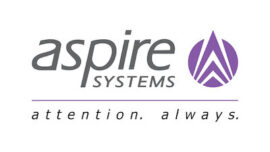Digital banking – realising the opportunity
Suresh Ranganathan, vice president and global head of banking business unit and Temenos relationship, Aspire Systems, talks about the company and its ambition to be at the forefront of digital banking transformation.
Tell us about Aspire Systems and its journey in digital banking. How has the solution evolved and why?

Suresh Ranganathan, Aspire Systems
Aspire Systems is a leading global software services company specialising in comprehensive, technology-led business solutions for the banking and financial services (BFS), retail, insurance, and independent software vendor (ISV) sectors. The firm has a strong commitment to innovation and excellence.
Our central theme in implementing digital banking solutions revolves around enhancing customer onboarding, digital engagement, and customer service, while empowering banks to provide hyper-personalised products. We are dedicated to harnessing these capabilities to pioneer digital banking innovation and elevate user experiences for our clients.
To date, we have successfully completed over 50 digital banking implementations, powered by the Temenos digital banking solution, spanning both previous and current iterations.
Tell us more about Aspire’s relationship with Temenos.
Our enduring partnership with Temenos spans over eight years of collaborative efforts. It has been a journey marked by steadfast progress, driven by purpose.
Beginning with internet banking portals, mobile apps, and APIs, our 2014 strategic partnership with Temenos resulted in the implementation of UXP-powered cross-platform apps, significantly reducing development time. By embracing Temenos Connect Internet and Mobile Banking (TCIB/MB), we also accelerated go-to-market strategies and enriched global features.
Temenos’ Infinity Digital Banking platform, supported by layers including presentation, integration, and microservices, guarantees seamless service continuity, even offline. The platform’s inherent flexibility and plug-and-play services both foster innovation. It also boasts a marketplace where value-added services like multi-factor authentication, personal finance management, identity verification, etc, are available as plug-and-play options, enhancing user experiences

Temenos and Aspire partnership: a journey marked by steadfast progress, driven by purpose
Through our ongoing collaboration, we have earned global certification as an implementation partner for Temenos’s end-to-end solution. We also hold certifications as an Infinity development partner, a financial inclusion partner, and a migration and upgrade expert. Our successes, coupled with our commitment to certification, expert skills, and client feedback, have positioned us as the preferred global partner for implementing the Temenos Infinity solution.
Beyond implementations, the firm is investing in enhancing Infinity by developing country layers. We are starting with key markets and countries, with plans for a phased roll-out. This strategic move aims to further enrich the solution’s appeal and effectiveness.
Aspire’s dedication to this partnership and our strategic investments reflect our vision of co-shaping the future of digital transformation on a global scale, positioning Temenos Infinity as the preferred multi-experience development platform (MXDP) across all tiers of the banking industry.
How has digital banking changed across geographies and over time?
In the late 1990s and early 2000s, banks introduced online platforms enabling customers to conduct basic tasks such as transfers and bill payments. Developed economies took the lead, while developing nations followed, overcoming infrastructure challenges step by step.
The mobile banking came next; the advent of smartphones ignited capability which went from the ability to check balances to functions like mobile check deposits, P2P payments, and more. Notably, even regions with limited banking infrastructures like Kenya pioneered mobile money with M-Pesa.
The fintech revolution from the mid-2010s onwards saw a wave of fintech start-ups emerge, offering innovative digital-first solutions. Digital-only banks like Monzo and N26 gained traction, providing seamless account set-up and unique features. This wave rippled across the globe, particularly in Europe and Asia, where WeChat Pay and UPI reshaped payment landscapes.
The COVID-19 pandemic acted as a catalyst for digital banking adoption, propelled by lockdowns and remote living. This digital surge aided financial inclusion, particularly in regions where traditional banking access was limited.
We are now moving towards Banking-as-a-Service (BaaS): a thought-provoking model where non-banking entities harness the established banks’ infrastructure to offer financial services. In this model data is the new oil, fuelling artificial intelligence (AI) which sits is at the forefront, revolutionising personalised banking experiences, risk assessment, and fraud detection.
Across regions, the driving force remains the same: making banking more convenient, accessible, and innovative. It’s truly an exciting journey in the world of digital banking.
Across regions, the driving force remains the same: making banking more convenient, accessible, and innovative. It’s truly an exciting journey in the world of digital banking.
Suresh Ranganathan, Aspire Systems
What about digital banking and the various segments of the banking sector? How has that evolved and where and how is digital banking used in each?
Digital banking has permeated various segments of the banking sector, each adapting and integrating technology in unique ways to improve efficiencies, customer experiences, and service offerings.
In retail banking, customer self-service, assisted by chatbots and AI assistants, has come to the fore. Customers are able to leverage mobile platforms to better manage their finances and access digital lending platforms and P2P lending.
Within corporate and business banking, digital platforms integrate with enterprise resource planning (ERP) for seamless transaction processing, reconciliation, and financial management. There are also advanced payments and trade finance solutions. And in particular, blockchain and digital platforms are being used for better efficiency.
Within investment banking, algorithmic trading and digital advisory tools provide automated services. Digital tools also work to analyse market trends, forecast, and make informed investment decisions.
And within wealth management there are personalised dashboards to provide a consolidated view, digital onboarding tools, and digital communications channels.
Where do you see the biggest opportunities digital banking?
Digital banking presents ample opportunities across different geographies and for various financial institutions. In each geography, while the specifics may vary, the overarching theme is that digital banking offers the chance to enhance member or customer experience, improve efficiencies, and compete effectively in an increasingly digital financial landscape.
Other themes common to all geographies include collaborations with fintechs where building societies and credit unions can benefit from strategic partnerships or collaborations. And by leveraging AI and machine learning (ML), institutions can offer enhanced data analytics to offer personalised products, anticipate member needs, and improve risk management. Diversification of digital offerings also allows for expansion into new areas like digital insurance, investment platforms, or cryptocurrency services can diversify offerings and attract new members.
How are maturity levels when it comes to digital banking?
Unfortunately, there are many areas that are still lacking when it comes to digital banking. A seamless omni-opti channel experience remains a distant dream for some while full, end-to-end digital processes are also a long way from being realised. Banks have also yet to implement personalisation techniques that is impactful in providing better customer experience and integration of emerging technologies, such as blockchain is patchy at best.
While many have embraced digital tools, the shift towards a complete digital-first strategy, culture, and mindset is still ongoing from both banks and clients.
The barriers to achieving digital maturity are many but include reliance on legacy systems and regulatory concerns and lack of clarity. There are also security concerns and cultural resistance to change and a lack of direction from the top also plays a part. There are also skills gaps and talent shortages.
So while many banks are on the right path toward digital maturity, the journey is ongoing. The evolving nature of technology and customer expectations means that continuous adaptation and innovation are necessary. Banks that can navigate these challenges effectively will be best positioned to thrive in the digital age.
Sponsored by Aspire Systems












































